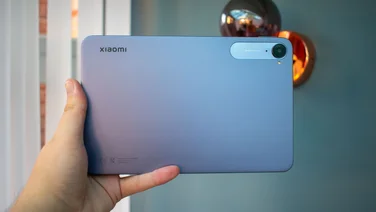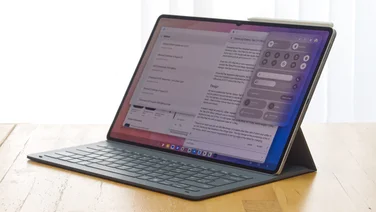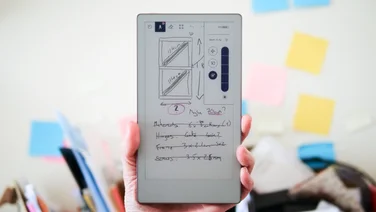To help us provide you with free impartial advice, we may earn a commission if you buy through links on our site. Learn more

Asus has plenty of experience making low-cost Android tablets, being the company behind both of Google’s excellent Nexus 7 tablets. Asus has applied this knowledge to its MeMO Pad HD 7, with impressive results. For this year’s MeMO Pad 7, Asus has ditched the ARM-based processor of the previous version and opted to use an Intel chip; the quad-core 1.33GHz Intel Atom Z3745.
The new processor gave us one of the most surprising performance scores we’ve seen in our SunSpider JavaScript benchmark. We were astounded that such a cheap tablet could complete the test in just 598.3ms. This is almost twice as fast as the Google Nexus 7 and even faster than both the Samsung Galaxy Tab S 8.4 and Sony Xperia Z2 Tablets. The MeMO Pad 7 really punches above its weight when it comes to browser performance, and felt incredibly responsive when browsing web pages.
This is one area where it really pulls ahead of its identically-priced rival, the Tesco Hudl. Where the Hudl can feel sluggish when rendering web pages and scrolling around them, the MeMO Pad has beautifully smooth scrolling and zooming. It’s an excellent tablet for web browsing.
Even gaming performance was beyond what we would expect for a tablet at this price. In our 3DMark Ice Storm Extreme test, the MeMO Pad 7 managed a very respectable 7,386, putting it just ahead of the Google Nexus 7 and far ahead of the Hudl’s 2,683. The difference was more considerable in the Ice Storm Unlimited test, with the MeMO Pad 7 racking up a score of 13,521 to the Nexus 7’s 10,224 and putting it at the same level as the far more expensive Samsung Galaxy Tab S 8.4. The MeMO Pad 7 is going to be able to handle any gaming you might throw at it, which is a real boon for a tablet at this price. Bear in mind that, as this is an Intel tablet, you may find the occasional app or game that won’t work, but everything we tried was fine.

Even the MeMO Pad 7’s build quality is impressive. It’s a fraction smaller than the Google Nexus 7, but is slightly thicker at 9.6mm. It’s also 5g heavier, but you won’t notice the extra weight during use. The MeMO Pad 7 also comes in a variety of colours including the standard black or white, but there are also more bold yellow, blue and red options for those wanting to make a statement. Our red review model was certainly eye-catching and made for a nice change from the standard black Android tablets we usually see.
The tablet feels solidly constructed, and there was barely any flex to the screen or the chassis, something you sometimes see in cheaper tablets. The design is otherwise clean and simple. On the top you’ll find the headphone jack and the Micro USB charging port. On the right are the power button and volume rocker, but strangely the power button is located below the volume, which took some getting used to.
On the left you’ll find a microSD expansion slot, which supports cards up to 32GB in size to supplement the 16GB of built-in storage. The slot isn’t covered by a flap, which is a bit worrying from a dust point of view, but it is recessed enough that you’re unlikely to eject the card accidentally. On the rear is a mono speaker at the bottom of the tablet.
Of course, Asus has had to make some concessions to create such a low-cost tablet. For example, the screen has an IPS panel with a 1,280×800 resolution, which is in no way comparable to the Google Nexus 7’s incredible 1,920×1,200 panel and has a lower resolution than the Tesco Hudl’s 1,440×900 display, so text doesn’t look as sharp as either display. We measured the MeMO Pad screen’s contrast ratio as 685:1, which is fairly low even for a cheap tablet; the contrast isn’t helped by the tablet’s low measured screen brightness level of 197cd/m2.
In comparison, the Tesco Hudl, which is the same price as the MeMO Pad, has a screen with a higher contrast ratio of 993:1 and is much brighter at 343cd/m2. Asus’ tablet wins out when it comes to colour accuracy, however, covering 87.5% of the sRGB colour gamut compared to 63.8%. This is confirmed when you put the tablets side by side, where the Hudl showed a slight yellow cast compared to the MeMO Pad’s pure bright whites.
The screen’s viewing angles are perfectly acceptable, and there’s a Reading Mode setting available from the quick toggle menu that reduces the contrast of the display to make reading more comfortable. We found it also made the screen colour temperature warmer, which did help make the display easier on our eyes.

The MeMO Pad 7 runs Android 4.4 KitKat, the latest version of the OS, but this has been tweaked with Asus’ own ZenUI skin. This has a few nice changes over stock Android, including an updated lockscreen that shows you weather and calendar updates along with shortcuts to the Browser, Camera and email apps.
Asus has also included its own Camera app which has a few extras compared to the default Android app. There’s a Time Rewind setting that takes a number of frames in quick succession, before and after you actually press the shutter button, allowing you to then select the best shot.
Selfie mode allows you to first set the number of people participating in the self-portrait and then the camera uses face detection to automatically take a photo, allowing you to use the superior rear-facing camera for your group shot rather than the front camera, as is usual for selfies. In practice, however, we found this worked fine for a single person but we couldn’t get it to detect any more than one face consistently, resulting in a lot of awkward posing and waiting. There’s also a fun animated GIF creation mode.

Camera image quality is passable in good lighting, but there’s a lot of noise in more difficult low-light situations; it’s not a great camera, but we weren’t expecting amazing quality considering the MeMO Pad’s cost.
The Asus MeMO Pad 7 is a pleasant surprise. It’s a great tablet for the price, with good performance and battery life. Just as the Google Nexus 7 reinvented what we expected for tablets under £200, the Asus MeMO Pad 7 changes what we’d expect from a £120 tablet. We’d be tempted to find another £50 for the superior Nexus 7, but if you’re looking to pick up a competent tablet for little money, it’s a fantastic choice.






